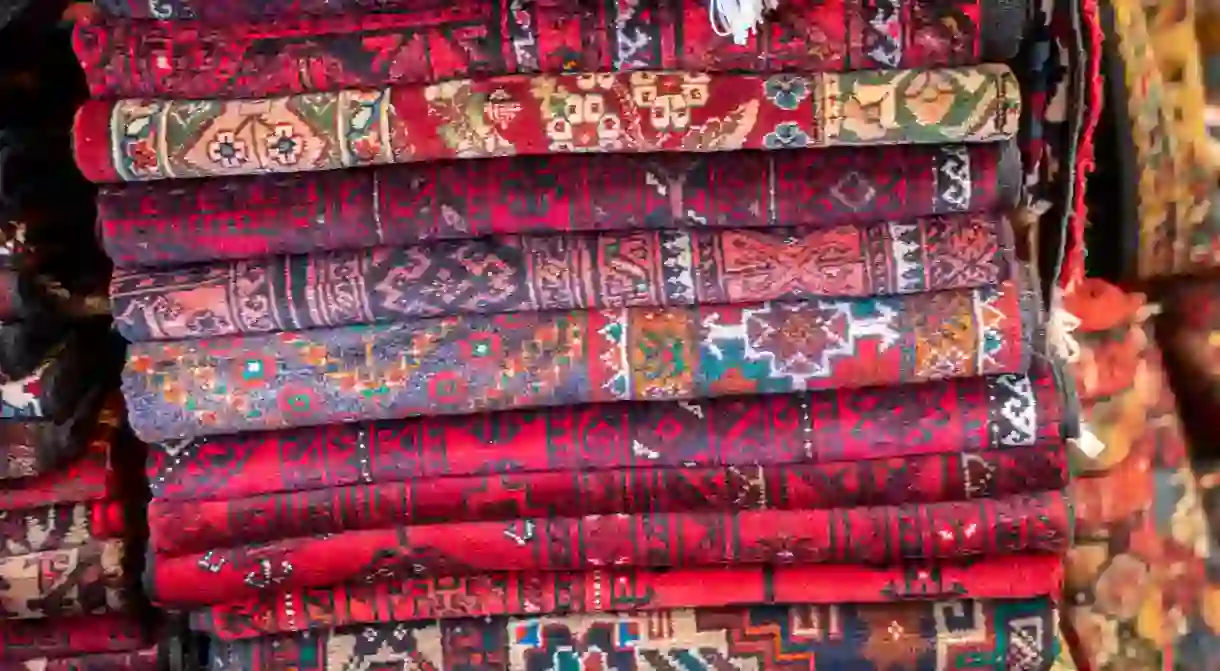Tips for Buying the Perfect Persian Carpet

Every city in Iran has a unique handicraft that makes a memorable souvenir, but buying the perfect Persian carpet has to be the ultimate prize. It’s easy to become overwhelmed, though, with so many types and patterns available, so we’ve put together this handy guide.
Strolling through an Iranian bazaar where there are Persian rugs for sale, with insistent sellers calling you to their stores, can be dizzying – so you need to have the proper ammunition in your battle for a bargain. Knowledge is power, and knowing the holy trinity of carpet buying will arm you with the information and confidence you need.
The knot count
A traditional Persian rug is handwoven on a loom, and one of the most important features to look out for is the knot count. A quality rug will have at least 120 knots per square inch (6sqcm). To appear a carpet connoisseur in front of the seller, flip the rug over and look at the knots from the underside. You’re not expected to count them, but the back of a carpet has a lot to say. A handmade rug will have a soft backing with a few bigger knots, while a machine-made one will raise an eyebrow due to the knot uniformity. Even in the city of Tabriz, one of the oldest Persian carpet weaving centres in Iran, the knot count will vary from rug to rug.

The material
Handwoven Persian carpets are typically made of wool, silk or a wool-silk blend. Generally, 100 percent pure silk rugs are quite fine and have a shiny finish. Wool is the most commonly used material. The quality depends on the breed of sheep, the climate, the pasture and the time of shearing. Don’t mistake these two quality flame-resistant materials for the synthetic fibres of machine-made carpets, which are highly flammable and tend to give off lint.

The colour
Traditional Iranian carpets are made with natural dyes, so look for colours that seem to come from nature: cochineal insects for reds, indigo plant for blues and pomegranate rind for shades of yellow. Synthetic dyes tend to penetrate the fibre evenly, whereas natural dyes coat the surface. Bend the carpet to isolate a few threads; if you notice a subtle unevenness you know you’re dealing with natural colours.

Now that you know the three most important factors to look for in a Persian rug, here are a few other pointers to help you narrow down your choice further.
Set a budget
Prices for Persian carpets vary about as much as their dizzying array of floral and geometric patterns, so set a budget. Silk rugs will be at the expensive end of the spectrum, with the rarer material and higher knot count coming at a higher price. Because wool is more readily available, wool rugs will be more affordable. If you’ve got a limited budget, consider a new trend rising in popularity: quilt-like carpets made with squares of old rugs patched together.
Determine its use
Think about where you want to place your carpet and what you’ll use it for. Although they may be the ultimate luxury item, silk rugs are less resistant to stress and therefore serve a more decorative purpose, sometimes even being hung on the wall. Wool rugs are more practical, as they are durable and can handle a high volume of foot traffic for decades (even centuries) without showing signs of distress. And for those who have young children, they are excellent at disguising any spills or mishaps.
Know the difference between types
Not all Persian carpets are created equal, and it’s not unusual for novices to mistake a gelim (a flat woven carpet) or a gabbeh (a pile rug commonly woven by nomads) for a traditional Persian carpet just because it’s from Iran. These varieties are beautiful in their own right, but be sure you know the difference so you don’t invest in the wrong type.

Fall in love with a pattern
Floral? Geometric? Paisley? Traditional? Tribal? carpet patterns differ greatly depending on what area of Iran they come from. Get a feel for what your options are as you walk through the bazaars or window-shop. Rest assured, there’s a pattern out there for everyone.

Haggle
Finally, nobody wants to be taken for a ride, so a bit of haggling is in order. But when it comes to Persian carpets, you get what you pay for. And while you don’t want to overpay, something too cheap will eventually show its quality. As a rule of thumb, remember that you are investing in a piece of art. Iranian carpets are painstakingly labour-intensive to create, with weavers sitting hunched over a loom for thousands of knots for several months to several years, depending on the size. In the end, as long as you think you’re paying a fair price, consider it a good deal.

Did you know – Culture Trip now does bookable, small-group trips? Pick from authentic, immersive Epic Trips, compact and action-packed Mini Trips and sparkling, expansive Sailing Trips.













